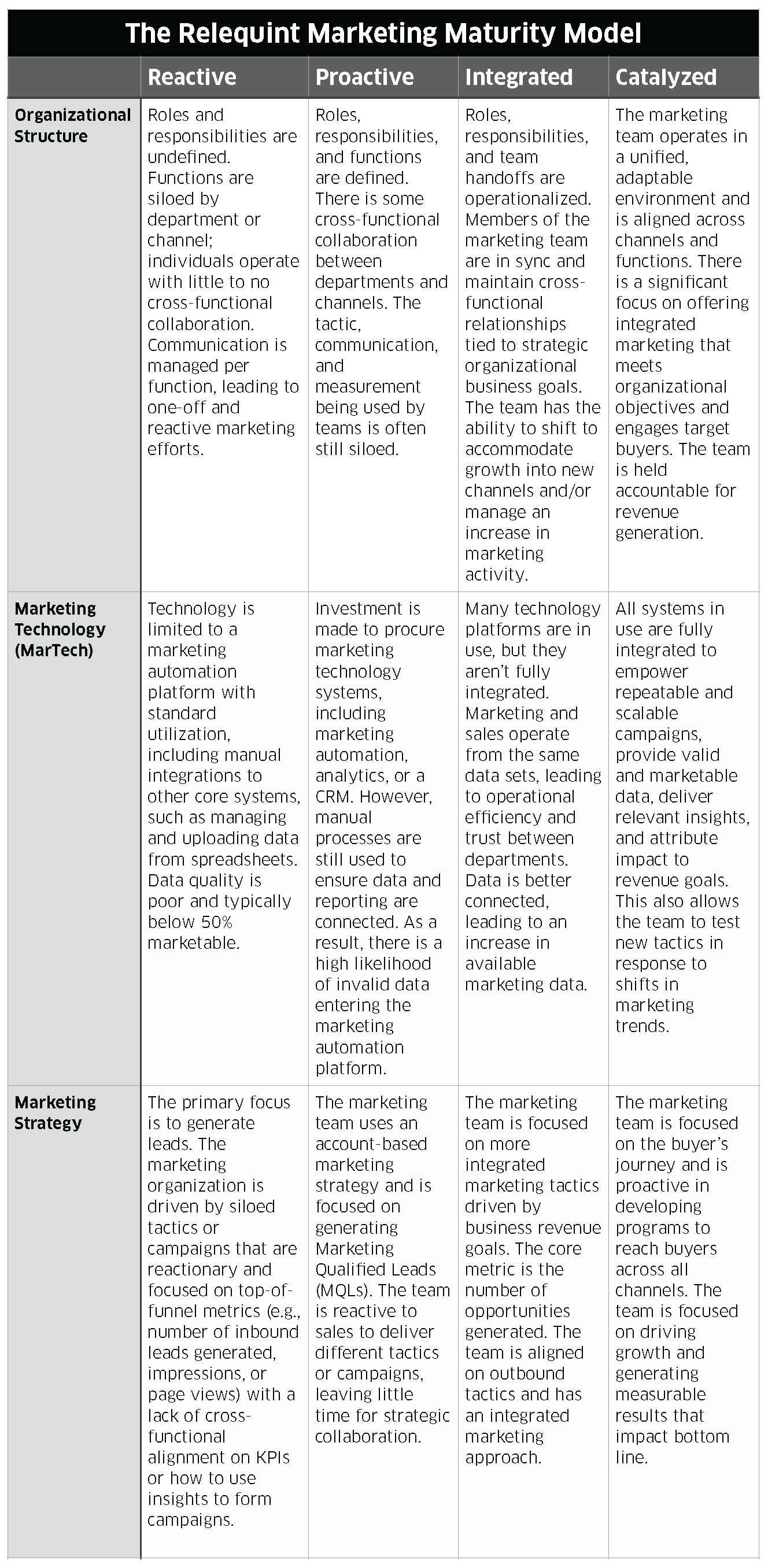When we talk about B2B marketing maturity, we’re really asking one critical question: To what extent are you making your marketing decisions based on well-thought-out strategy, real data, and alignment to business outcomes?
You probably have an answer in your head right now. But it’s important to remember that most B2B organizations think they’re more mature than they really are.
Do you know where your business currently stands? Here’s an overview of the four stages of market maturity.
The 4 Stages Of Marketing Maturity
The fundamental requirements of a business change over four distinct stages as it transitions from a stage of growth to maturity. Let’s look at these stages using names from the Relequint Marketing Maturity Model, which we’ll detail in depth later.
First Stage: Reactive
Your marketing efforts are dispersed, underfunded, understaffed, or all of the above in this situation. You might have some fundamentals in place. You might publish the occasional e-newsletter, host a few conferences, and allow donations and event registration on your website. But that's pretty much all.
The marketing budget is meager to nonexistent. The leadership needs more buy-in. The staff needs more resources and expertise to start new initiatives. There need to be clear objectives. Instead of being proactive, strategies are more reactive.
Second Stage: Proactive
This is the second of the four stages of marketing maturity. Lack of urgency discourages investment. Experience and anecdotes, not research and evidence, influence decisions. The technology is dated or awkward. The website user experience is merely adequate. It's common for strategies to be more reactive than proactive.
There is still a lot of possibility for development at this stage. You must locate and close any glaring holes in your communications strategies, such as those caused by a lack of channels, technologies, or research. This frequently entails implementing Google Analytics and an intelligent SEO approach for the first time. Still, it can also entail creating a new website design, creating a video plan, or conducting an internal audience analysis.
Third Stage: Integrated
Internal knowledge has reached its limits, including the incapacity to keep up with the most recent theories and tools. So far, everything has been successful. SEO, Google Analytics, and other, more comprehensive research initiatives frequently only go so far. Technologies are helpful, yet they have many features that need to be utilized. Projects and techniques are commonly founded on more than 2-3 years old ideas.
Despite being in front of the competition, there is still much opportunity for improvement. You're doing some complex things well, like using data to inform your decisions, running a top-notch website, and having good technology. However, there is much-unrealized potential. You are aware of the importance of excellent marketing, and you can easily relate those initiatives to overarching company objectives.
Fourth Stage: Catalyzed
Budgetary constraints frequently force ambitious ideas. It can be challenging to explain the specifics of your communication efforts to leadership (and other departments). Because there is no content governance in place, as you produce more content, there is a chance that it will stray from your standards and brand.
You want to increase your organization's size and quality by ten times, but you need to figure out how to achieve such a significant change. You can rest easy knowing that you are mainly succeeding in your marketing goals. Your customer advocates are expanding, you're meeting your KPIs, and you're doing what marketing is supposed to do: winning the day.
Putting It All Together: The Relequint Marketing Maturity Model
Now that we’ve introduced the four stages of marketing maturity, let’s review how they all fit together. Below is the Relequint Marketing Maturity Model, focusing on three main areas: organizational structure, marketing technology (MarTech), and marketing strategy.

How A Marketing Maturity Model Strengthens Your Business
Relequint assists business owners in developing distinctive marketing maturity models that accurately reflect the stages of growth that most technology solution companies go through by drawing on vast industry expertise. Business owners can use this approach to determine the maturity level of their company and the areas that require more attention if they want to grow and sustain it.
The model demonstrates how growth's natural progression impacts organizational alignment, people, processes, and tools. We differentiate the go-to-market maturity of each growth stage across sales, marketing, and delivery, which makes the model special. Contact us to learn more about the four stages of marketing maturity and how your business can rise to the occasion.







 By
By 
